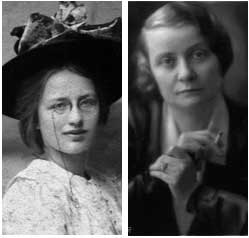Author: Soila Lehtonen
Writers meet again in Lahti
14 May 2009 | In the news
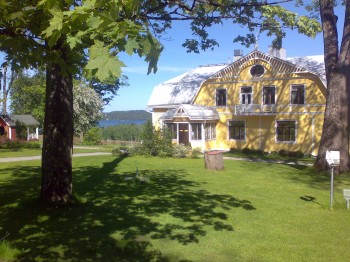
In other words: LIWRE at Messilä Manor
The Lahti International Writers’ Reunion (LIWRE; www.liwre.fi) will be held this year between 14 and 16 June.
In the politically and culturally active 1960s, marked by the confrontation between East and West, an idea was born to found an international, bi-annual rendezvous where writers from all over the world could freely engage in discussions on various themes.
Eino Leino Prize to Hannele Huovi
17 April 2009 | In the news

Hannele Huovi. - Photo: Laura Vesa
‘Methinks,/ said the sausage dog / who loved eating verse, that / poetry is tastier than bone.’ (From Karvakorvan runopurkki [Furry pooch’s jar of verse])
Hannele Huovi (born 1949) has received the 2009 Eino Leino Prize, worth € 5,200 and funded by the Finnish Book Foundation, for her extensive work as a writer of books for children and young people, of novels, poetry and text books. More…
Funny stuff
1 April 2009 | In the news
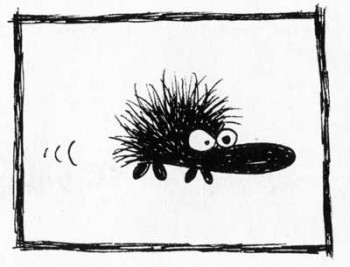
Milla Paloniemi's swearing hedgehog
For the first time, comic books rule the latest bestsellers list of Finnish fiction.
A cartoon series called Fingerpori by Pertti Jarla evidently tickles the Finnish funny bone, as three of his collections occupy the second, sixth and eighth places on the February top ten list, compiled by the Booksellers’ Association of Finland. More…
Maire Gullichsen: Regnbågsfärger, mörka stänk. Minnesvandringar 1907–1928 [Rainbow colours, dark shadows. Journeys in memory 1907–1928]
19 March 2009 | Mini reviews
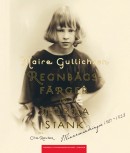 Maire Gullichsen: Regnbågsfärger, mörka stänk. Minnesvandringar 1907–1928
Maire Gullichsen: Regnbågsfärger, mörka stänk. Minnesvandringar 1907–1928
[Maire Gullichsen: Rainbow colours, dark shadows. Journeys in memory 1907–1928]
Red. [Ed. by] Cita Reuter
Helsingfors: Svenska Litteratursällskapet in Finland, 2008. 357 p., ill.
ISBN 978-951-583-165-1
€ 40, hardback
Maire Gullichsen, née Ahlström (1907–1990), an inheritor of the influential Ahlström timber, paper and metal company, was a prominent promoter of Finnish modern art, design and architecture and an art collector. In 1935, together with the architects Alvar and Aino Aalto and the journalist Nils-Gustav Hahl, she founded the design company Artek, which is still in business today. This book is based on her hitherto unpublished memoirs in which she recorded her life up to her marriage, to Harry Gullichsen, in 1928. Their home, Villa Mairea (1939) in the Ahlström family’s home district of Norrmark (Noormarkku) on Finland’s west coast, was designed by Alvar Aalto and remains one of the iconic examples of organic modernism. This richly illustrated volume gives a lively, detailed picture of a wealthy family during the tumultuous years of rapid industrialisation and struggle for independence in Finland. Maire Gullichsen’s daughter Professor Lilli Alanen and art historian Helen Woirhaye complement the author’s memoirs with articles providing information on the years after 1928.
Hannele Huovi: Karvakorvan runopurkki [Furry pooch’s jar of verse]
4 March 2009 | Mini reviews
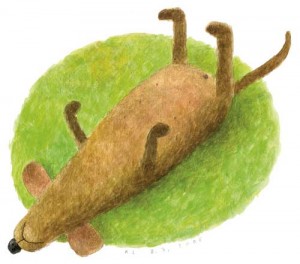 Karvakorvan runopurkki
Karvakorvan runopurkki
[Furry pooch’s jar of verse]
Kuvitus [Ill. by]: Kristiina Louhi
Helsinki: Tammi, 2008. 79 p.
ISBN 978-951-31-3974-2
€ 23.30, hardback
‘Methinks,/ said the sausage dog / who loved eating verse, that / poetry is tastier than bone’. Hannele Huovi (born 1949) has written poetry, books for children, novels and fables. The masterly rhymes of Finland’s grand old lady of children’s poetry, Kirsi Kunnas (born 1924), are hard to match, but Huovi comes close. For her, Finnish is easily pliable; her rhymes do not try to be too clever, her tone of voice is warm and humorous, and often the poems are little stories in the tradition of nonsense verse. Huovi’s sense of humour matches perfectly with Kristiina Louhi’s pastel pictures which often add surprising dimensions to the poetic stories. ‘So complete / trust can be: / with your paws skywards, /with your belly bared, you can / lie in the grass.’
Tove Appelgren & Salla Savolainen: Vesta-Linnéas svartaste tanke [Vesta-Linnea down in the dumps]
4 March 2009 | Mini reviews
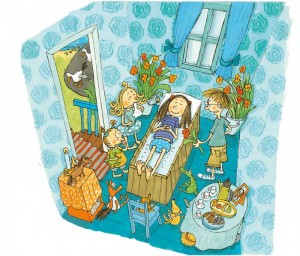
Vesta-Linnéas svartaste tanke
[Vesta-Linnea down in the dumps]
Helsingfors: Söderströms, 2008. 34 p., ill.
ISBN 978-951-52-2568-9
€ 17, hardback
Vesta-Linnea mieli mustana
Suomentanut [Translated into Finnish by] Tittamari Marttinen
Helsinki: Tammi, 2008. 34 p., ill.
ISBN 978-951-31-4204-9
€ 15.20, hardback
Vesta-Linnéa’s family consists of her mother, stepfather, two younger sisters and a big brother. In her opinion, little sisters can be unbearably stupid, and mother understands nothing. In this fourth book about Vesta-Linnéa, the enraged heroine imagines her own funeral after a serious row with her sisters: she would make a beautiful corpse, and then everyone would surely cry their eyes out. Or would they? Appelgren (born 1969) concisely depicts a popular daydream of revenge among little girls with humour. Salla Savolainen’s colourful, comical, detailed but relaxed cartoon-like illustrations work well with the text. And mother turns out to be not so lacking in understanding after all.
Dear reader,
11 February 2009 | Letter from the Editors
welcome to the new Books from Finland website. After 42 years in print, we now navigate virtual worlds. However much Books from Finland may have changed in appearance, though, its essence remains the same – as always, we try to provide you with interesting, well-translated things to read. Made in Finland, or about Finland. More…
Sofi Oksanen: Puhdistus [Purge]
5 February 2009 | Mini reviews
![Sofi Oksanen: Puhdistus Sofi Oksanen: Puhdistus [Purge]](https://booksfromfinland.fi/wp-content/uploads/2009/02/puhdistusweb-130x164.jpg) Puhdistus
Puhdistus
[Purge]
Helsinki: WSOY, 2008. 380 p.
ISBN 978-951-0-33973-2
€ 29.90, paperback
Sofi Oksanen’s first play Puhdistus (‘Purge’) was staged at Finland’s National Theatre in 2007. Oksanen (born 1977) has an Estonian-Finnish background and studied at the Theatre Academy. Puhdistus, her third novel, retells the story of her play about two women and moves through the past by flashbacks between 1939 and 1992. Aliide has experienced the horrors of the Stalin era and the deportation of Estonians to Siberia, but she herself has to cope with the guilt of opportunism and even manslaughter. More…
Olli Jalonen: 14 solmua Greenwichiin [14 knots to Greenwich]
30 December 2008 | Mini reviews
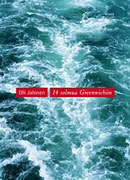 14 solmua Greenwichiin
14 solmua Greenwichiin
[14 knots to Greenwich]
Helsinki: Otava, 2008. 381 p.
ISBN 978-951-1-23014-4
€ 34.40, hardback
The ‘knots’ in the title refer to the 14-part control device in a competitive expedition that the participants have to use to check in at the control points. The Finn Petr Järvi leaves London together with his scientist friend Graham and Graham’s wife Isla on a year-long contest, held in honour of the 350th anniversary of the scientist Edmund Halley. More…
Literary prizes
15 November 2008 | In the news
In November six novels were shortlisted for the twenty-fifth Finlandia Prize for Fiction, to be awarded on 4 December.
Portraits and bagatelles
30 September 2008 | Fiction, Prose

Kaarina Valoaalto. Photo: Tammi.
Soila Lehtonen on Kaarina Valoaalto’s new collection of short prose
In Kaarina Valoaalto’s prose ‘the river, made wild by a storm, gallops, foaming at the mouth, down between the stays of the street banks and into the sea’ and ‘the fly is a classic’: ‘its buzz sounds the cycle of the year and all of the scales of feeling. A fly brings together agrarian and urban culture…. When I hear it, I believe I’m alone in the cabin of a sailboat, anchored to the bottom of a bay where terns and seagulls call out on the gleaming blue of the open sea and no there is no coffee because no one has bothered to make it’. More…

